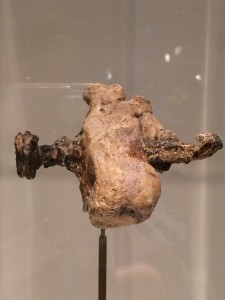By Gaye Strathearn
In antiquity crucifixion was a choice of punishment since the time of the Persians, but it was undoubtedly the Romans who perfected it as a form of torture. The Jewish historian Josephus described crucifixion as “a most pitiable death” (Jewish War 7.203).
We have numerous ancient accounts that mention crucifixion, but few of them describe the process in any detail. Nevertheless, these accounts generally corroborate the descriptions recorded in the four New Testament Gospels.
In antiquity crucifixion was performed in a number of different ways. Some victims were impaled;[1] others were tied to a cross or a tree[2]—sometimes they were nailed.[3]
Archaeologically, only one set of remains has been found of a person who was crucified in Palestine prior to 70 AD. We know that the person was crucified because the nail was still in the right calcaneum (or heel bone). [See the picture taken at the Israel Museum]. Sometimes the victims were crucified while alive, but sometimes it was after they were dead.[4] Sometimes the legs were broken in conjunction with the crucifixion.[5] By Roman times, crucifixion was preceded by flogging[6] and the victims were sometimes required to carry the beam of the cross.[7] Usually the bodies were left to be devoured by birds and wild animals,[8] but in Roman times, it was possible for the family to petition to take the body and bury it once death had been verified.[9]
Crucifixion was chosen as a form of execution, especially for murderers, thieves and traitors, and slaves because it was public and humiliating, and because the torture could be extended for long periods of time.[10] Continue reading






